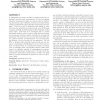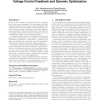32 search results - page 3 / 7 » Dynamic Design of Cellular Wireless Networks via Self Organi... |
WDAG
2001
Springer
13 years 10 months ago
2001
Springer
Self-stabilizing algorithms for constructing a spanning tree of an arbitrary network have been studied for many models of distributed networks including those that communicate via ...
PPOPP
2003
ACM
13 years 11 months ago
2003
ACM
Sensor networks are long-running computer systems with many sensing/compute nodes working to gather information about their environment, process and fuse that information, and in ...
MOBIHOC
2007
ACM
14 years 5 months ago
2007
ACM
A substantial percentage of links in wireless networks, especially low-power ones, is asymmetric. For the low-quality direction of asymmetric links, we observe based on testbed ex...
SIGMETRICS
2000
ACM
13 years 5 months ago
2000
ACM
Ad hoc wireless networks are new communication networks that can be dynamically formed and deformed onthe- y, anytime and anywhere. User data is routed with the help of an ad hoc ...
ISLPED
2004
ACM
13 years 11 months ago
2004
ACM
Microprocessor designers use techniques such as clock gating to reduce power dissipation. An unfortunate side-effect of these techniques is the processor current fluctuations th...


